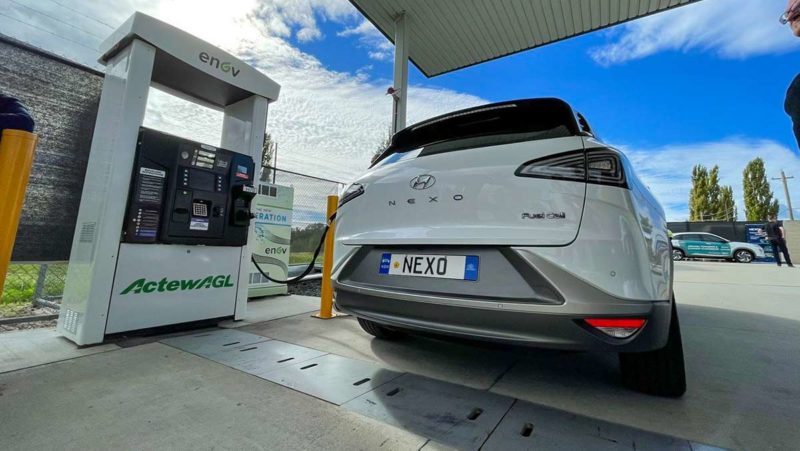Last week at the Las Vegas Consumer Electronics Show, Volkswagen CEO Thomas Schafer said the world’s second largest automaker would not develop hydrogen-powered cars, and would focus instead its efforts on electric vehicles.
Although Volkswagen now appears to have put hydrogen in the bin, other big automakers such Toyota, Hyundai, Honda and BMW continue to invest heavily into the technology.
Check the date. It’s February 2023. Hydrogen-powered cars are still being discussed and even “developed” by some of the world’s largest automakers in 2023, who couch their multi-billion dollar plans as “hedging their bets” or engaging a “multi-pronged strategy”.
They even get politicians, like former prime minister Scott Morrison, to drive and pose with hydrogen cars. He wouldn’t, and didn’t, do that with an electric car, which is why the continued push into what many insist is a fundamentally flawed technology should be properly investigated.
Before looking at why legacy automotive companies, resource tycoons and the politicians that represent them, have been such huge advocates for hydrogen-powered vehicles over the last 20 years, it’s important to firstly outline why hydrogen-powered cars are so fundamentally flawed and will never come close to competing with battery electric vehicles.

Currently, there are hardly any on the streets anywhere in the world, bar a handful driven by politicians for photo-ops and a few bought by technology optimists. And there are many reasons why we won’t see mass adoption of hydrogen-powered cars any time soon.
These include complexity of design, thermodynamic barriers, logistical inefficiencies, enormous costs and safety issues. Of all the things that are rated likely as a use for green hydrogen, passenger cars and small vehicles rate down the bottom. There might be used in big vehicles like haulage trucks, but even that remains to be seen.
Big Auto, and Big Oil and Gas, like hydrogen technology for cars it because it looks and feels a lot like their current business models – complex engines that require heavy maintenance, and a centralised distribution system.
Many proponents will mention hydrogen’s energy density to justify the technology. They generally fail to mention they’re talking about liquified hydrogen – and the process of liquifying hydrogen is complex and energy intensive.
Hydrogen-powered cars, the “Rube Goldberg machine” of transport
Founder and chief scientist at Rewiring America, and the brains behind the “electrify everything” campaign, Saul Griffith describes hydrogen-powered cars as Rube Goldberg machines.
Named after an American cartoonist, a Rube Goldberg machine is a contraption which is designed to perform a simple task using a series of absurd and unnecessary steps which comically over complicate achieving the desired goal.
The original comic is of a self-operating napkin which is triggered when the diner lifts his spoon.
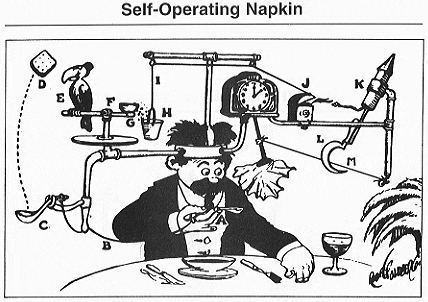
Comparing a hydrogen fuel-cell car with an EV, we can see what Griffith is talking about. Not only does the hydrogen car need electric motors and a battery like an electric vehicle, it also needs hydrogen tanks to store the hydrogen and the fuel-cell to convert the hydrogen into electricity.
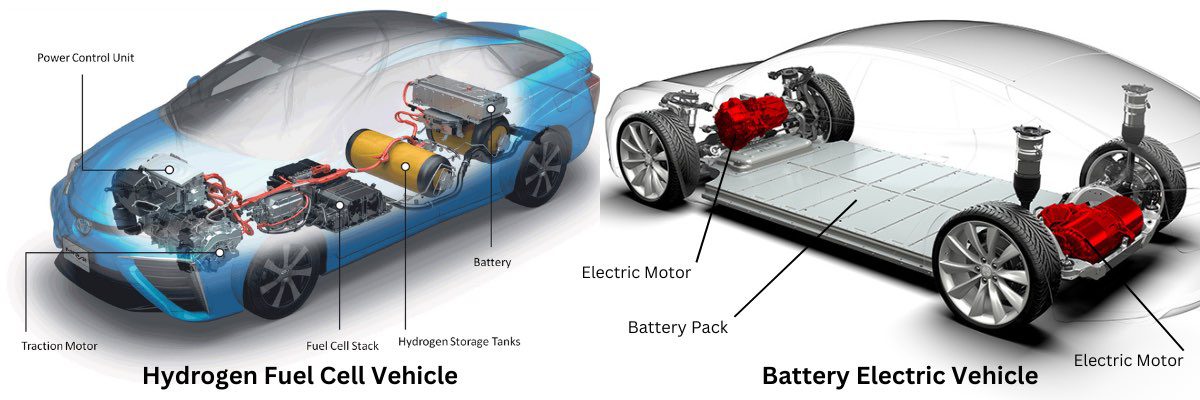
Comparing the two car designs we can see the hydrogen-powered car is far more complicated.
However, it’s not until we zoom out and look at the entire energy supply chain, that we start to see how unlikely the hydrogen-powered car really is.
The hydrogen supply chain closely resembles that of our current fossil-fuel-powered system.
For the last 100 years the vast majority of the world’s transport system has run on petrol and diesel.
The fuel needed to power petrol and diesel cars and trucks begins a long and complex journey as extracted oil on huge and complex oil rigs costing hundreds of millions of dollars. The oil is then either piped through expensive pipelines or shipped using expensive oil tankers to complex and expensive oil refineries.
At the complex and expensive refineries, the oil is turned into petrol or diesel and is then stored in massive expensive tanks before being trucked to an expensive fuel station where it’s again stored before you go and pump it out of an underground tank into your car.

In our fossil fuel dominated world this entire system is needed to get you from A to B. Hundreds of thousands of engineers, boilermakers, diesel mechanics, truck drivers and gas station attendants needed to deliver this energy into your vehicle.
The same holistic analysis must be applied to other transport technologies such as hydrogen and battery electric vehicles. The source of energy for both electric and hydrogen-powered vehicles is (must be) solar and wind powered electricity as the world transitions away from fossil fuels.
With battery electric vehicles, electricity can be generated from solar panels (rooftop or grid-scale) or wind power from wind turbines. This electricity is then stored in the vehicle’s on-board battery pack before its used to power electric motors to move the car.
With hydrogen-powered vehicles the system is far more complex and more closely resembles our current petrol and diesel “Rube Goldberg on steroids” system.
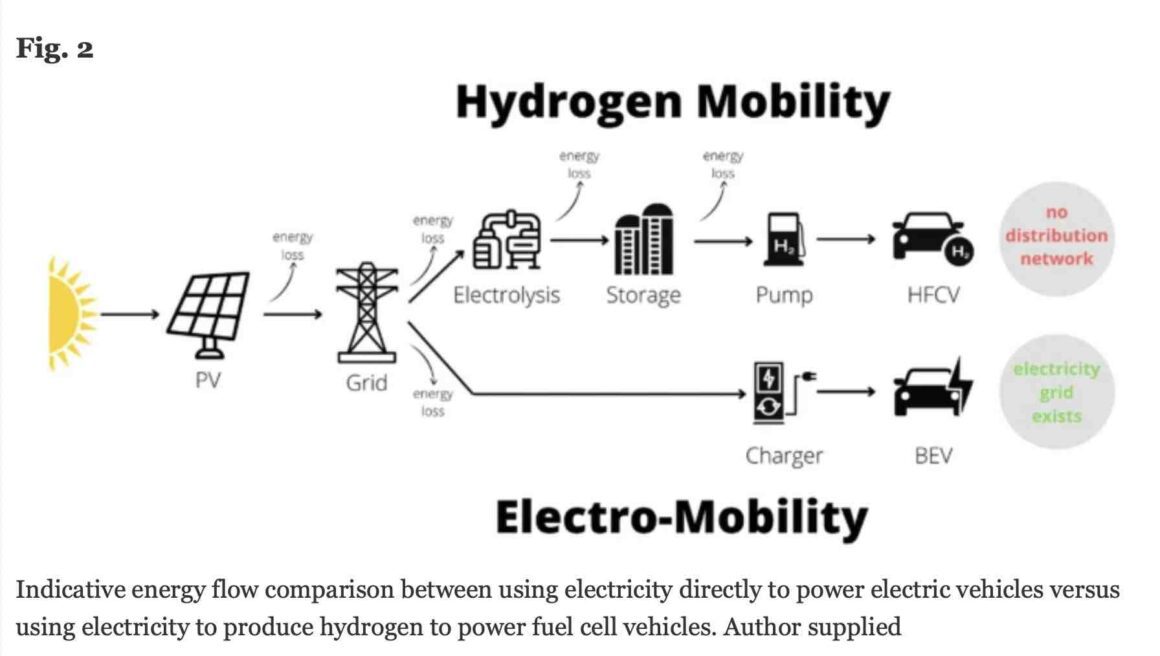
Curtin University’s Peter Newman and the University of Queensland’s Jake Whitehead make the same conclusions in their newly released research paper, published in Sustainable Earth Reviews.
“Energy is lost at every step of the energy chain, as dictated by the laws of thermodynamics, which in turn leads to higher energy input requirements, and ultimately higher energy costs,” they say.
And they illustrate this with the graph above comparing the energy chain required to power a hydrogen fuel cell vehicle (HFCV) compared to a battery electric vehicle (BEV).
In his book “The Big Switch” Saul Griffith lists the stages needed to power a hydrogen-powered car. Note that even before the first step, electricity needs to be generated by renewables such as solar and wind, in order for the hydrogen to be classified as “green”.
- Seperate the hydrogen from water or some other molecule (using electricity from renewables).
- Compress the hydrogen or cryogenically cool it, to make transportation feasible.
- Store the hydrogen in some sage pressure vessel.
- Transport the hydrogen to where it’s needed.
- Decompress the hydrogen so that you can utilise it.
- Either burn the hydrogen by mixing it with oxygen like a traditional engine (and maybe use that to turn a generator to make electricity) or…
- Put the hydrogen through a “fuel cell” to turn it directly into electricity.
All of the things in this incredibly complex system require materials, machines and energy to make and run.
In comparison the battery electric system is extremely simple and therefore efficient.
6/8
Why hydrogen is not a good idea. (Part 2) #ElectrifyEverything pic.twitter.com/Cday5tE614
— Daniel Bleakley (@DanielBleakley) February 13, 2022
Hydrogen’s “Rube Goldberg” complexity of converting renewable energy into physical movement of a car equates to enormous energy losses which means that, not only are hydrogen-powered cars complex, they are also woefully inefficient.
Hydrogen’s inefficiency problem
The next major problem facing the hydrogen-powered car is the laws of thermodynamics.
Every engine or system has an upper theoretical efficiency limit. Internal combustion engine vehicles are what’s known as “Carnot cycle” engines. For vehicles, Carnot cycle engines have an upper theoretical limit of around 37% however most car engines only reach about 20% efficiency in reality.
What this means is that for every litre of petrol you buy from the petrol/gas station, only 20% of the energy in that litre actually goes into moving your car. The other 80% is wasted producing heat and sound.
So after the enormously complex and expensive journey from the oil rig to your car, 80% of the fuel you buy is just burnt up for nothing, only contributing to air pollution and climate change.
Hydrogen-powered cars, which can be either combustion or fuel-cell, also have terrible theoretical upper efficiency limits. In “The Big Switch” Saul Griffith uses Sankey diagrams to compare these efficiency limits between electric vehicles and hydrogen-powered cars. The diagrams show the accumulated energy losses at each stage in the system.

Again these diagrams show the theoretical upper limits. In reality for hydrogen the efficiency is closer to just 20%. The electric vehicle efficiency numbers shown in the diagram above are actually conservative with some battery electric systems now achieving efficiencies of over 95%
What this all means in practice is that to get the same usable energy output to move a hydrogen-powered car, you need 3-5 times more energy input compared to a battery electric vehicle.
This means the energy cost to fuel hydrogen-powered cars is at least 3-5 times higher than EVs.
But it’s actually much worse than that.
It means you need 3-5 times more solar panels and wind turbines to supply hydrogen-powered cars.
That’s 3-5 times more capital costs to build those additional panels and turbines, and this is before we’ve even got to the next stages of the process, including Electrolysers, storage tanks, pipe networks, trucks, pumping stations plus all the workers’ wages needed to operate and maintain the supply chain.
By comparison electricity for electric vehicles is delivered straight into your garage like magic. Perhaps travelling just a few metres from your rooftop solar!
The hydrogen problem isn’t something engineers can simply “design out” of the system. There’s no technology breakthrough on the horizon that will enable hydrogen cars to get efficiency rates above 35%. Not unless engineers figure out a way to violate the laws of physics.
So if hydrogen is so woefully inefficient, complex and expensive, why are legacy automakers, politicians and resource tycoons always spruiking it?
Centralised versus decentralised energy. Hydrogen, a resource tycoon’s pipe dream
The battle between electric vehicles and hydrogen-powered cars could be better described as the battle between centralised and decentralised energy.
Hydrogen represents a continuation of the highly centralised and monopolised fossil fuel powered system, where a handful of oil companies control the entire world’s supply chain of transport energy.
This control over transport energy enables the global oil industry to wield immense power over governments around the world, enabling them to secure hundreds of billions of dollars in subsidies and suppress policies that benefit their competitors, like electric vehicles.
Alternatively, battery electric vehicles represent a decentralised system because the vehicle’s energy can be completely sourced from solar panels on your roof (or your neighbour’s roof).
This is why the global oil industry and the governments they’ve co-opted are so threatened by the electric vehicle revolution. Once people make the switch to EVs, they’re no longer dependent on massive multinationals for their energy or mobility.
The susceptibility for a future hydrogen supply chain to be monopolised has also attracted resource tycoons like Australia’s Andrew Forrest. In his 2021 Boyer lecture, Forrest claimed that green hydrogen is the solution to climate change.
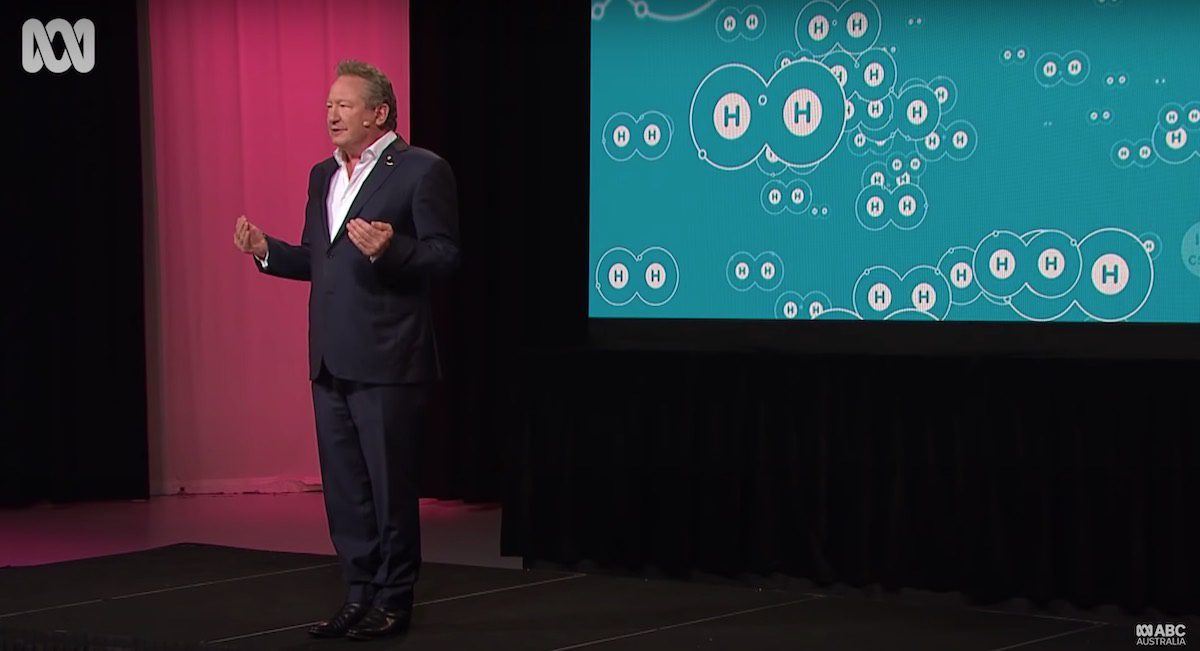
“Our technology leading neighbours, Japan, South Korea and China have together pledged to put almost 8 million, hydrogen fuel cars on the road in the next few years.” he said during the January 2021 lecture.
Forrest went on to say “Elon Musk recently called hydrogen fuel cell cars, despite the 8 million that will soon be on the roads, mind bogglingly stupid. He has every reason to fear them. His description is perhaps better suited to someone who pedals a battery technology as green, when it runs on fossil fuel.”
In the two years since Forrest’s lecture, his company has announced huge stretch goals for green hydrogen, but this is mostly for industrial use, not for cars. Tesla has sold over two million battery electric vehicles and is on track to produce almost two million more EVs in 2023. There have been only a few thousand hydrogen fuel cell vehicles sold.
Forrest himself is now also pursuing battery electric, and he has just announced plans to created a multi billion battery business from the recently acquired Williams engineering team.
His company has also taken delivery of the first big 15-tonne batteries for his huge haul trucks and developing the so-called infinity train, using batteries and regenerative technologies, for the huge trains carrying ore to ports.
Meanwhile in a press release last week, Honda has said it hopes to sell just 60,000 hydrogen fuel-cell cars by 2030. A date when many analysts believe electric vehicle market share will be well over 90% of all new cars sold globally. BMW also announced its plans to invest more in hydrogen fuel cells, saying it has a “strong belief” in the technology.
Economy wrecking decisions
It’s hard to imagine the top engineers at companies like Toyota and Honda not understanding the fundamental problems with hydrogen. The talk is that they have been pressured from high level executives to “just make it work” and have chosen to stay quiet rather than rock the boat.
Whatever the reasons, the decisions companies have taken to focus on hydrogen over the last decade are about to have massive consequences, not only for the companies themselves but for entire nation’s economies.
None more so than in Japan where Toyota and Honda have completely failed to develop high-volume electric vehicle manufacturing. This has essentially handed Japan’s dominant market position to China (and Tesla) who are ramping up electric vehicle production to fill surging global demand.
Japanese energy think tank Renewable Energy Institute, released a report in September last year titled Re-examining Japan’s Hydrogen Strategy: Moving Beyond the “Hydrogen Society” Fantasy. The report slams Japan’s 2017 national hydrogen strategy, which envisages a carbon-neutral “hydrogen society”, as catastrophically misguided.
Japan’s strategy aggressively pushes for hydrogen-powered cars while Japanese consumers overwhelmingly prefer EVs.
Japan’s automotive manufacturers and the industries that support them are estimated to employ over 5 million workers. Around 8% of Japan’s workforce. With the world now rapidly shifting to electric vehicles, which make up just 0.2% of Toyota’s production, it’s looking like Japan’s decision to focus on hydrogen over EVs is about to come back to bite them hard.
And it’s not just economies that are at stake here. The hydrogen “fantasy” has sown seeds of confusion into the public discourse for many years about which direction the energy transition is heading. This has undoubtedly slowed the world’s efforts to get off fossil fuels.
Hydrogen, the never ending story…
If it feels like hydrogen for cars has been talked about for decades, that’s because it has.
A Guardian article from 2011 titled “Why don’t governments push for more hydrogen cars?” begins with the sentence “We seem to have been talking about the ‘hydrogen economy’ for well over a decade now, but, like so many other saviour technologies, its arrival never seems to get any closer.”
The never ending narrative of “we’re developing hydrogen-powered cars” that stretches out into the future, suits legacy auto companies who are unable or unwilling to develop electric vehicles.
They tell their customers this vague technology will be ready in a few years. In the meantime please consider our petrol and diesel cars.
Hydrogen pushers should cut their losses and accept that EVs have won the technology war.
Consumers understand this. It’s time politicians and executives stopped pretending they don’t.

Daniel Bleakley is a clean technology researcher and advocate with a background in engineering and business. He has a strong interest in electric vehicles, renewable energy, manufacturing and public policy.

